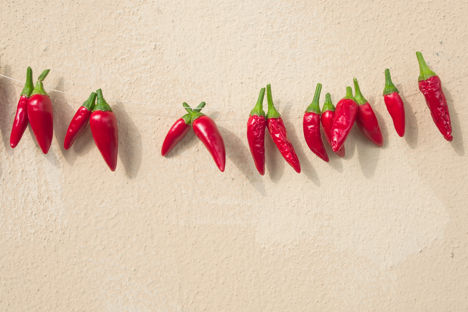
Diavolino: Abruzzo’s chilli pepper
There’s fire in the hearts of the people of Abruzzo. Whether it’s spring, summer, autumn or winter, little fresh or dried chillies find their way into all sorts of local dishes, adding a unique heat to the region’s cuisine.
Diavolino: Abruzzo’s chilli pepper
There’s fire in the hearts of the people of Abruzzo. Whether it’s spring, summer, autumn or winter, little fresh or dried chillies find their way into all sorts of local dishes, adding a unique heat to the region’s cuisine.
Abruzzo must be one of the only areas of Italy where a restaurant’s table setting often comes complete with a pair of scissors. Their purpose? To snip little pieces of locally grown chillies over dishes just before eating – an ingredient that’s integral to the region.
Diavolini (‘little devils’) have been the subject of a culinary obsession in this beautiful part of central Italy for many years now. Also known as peperoncino – the more general Italian word for chilli – they have become an icon of Abruzzese cooking and can be found year-round in various forms. They’ll be fresh and ready to snip in the summer and early autumn during their harvest but appear either dried or preserved in oil during the other seasons. They’re also crushed into flakes so they can be used in cooking or sprinkled over dishes alongside like salt and pepper. Visit the area at the right time (usually late summer) and you’ll see bunches of these little chillies threaded together and hung up outside houses, drying in the sun. Come winter, they’ll be used to add plenty of warming heat to meals to stave off the chilly weather and snow, which often blankets the more mountainous areas of the region.
But what is the reason behind this local love of chilli? It all comes down to the geography of the region. As a sparse and quite rural part of Italy, many of the traditional, historic dishes of Abruzzo are – out of necessity – focused around seasonal local produce. In Abruzzo, that generally means lamb or seafood (depending on where you are) with whatever vegetables are being harvested at that time. To make mealtimes a little more interesting, however, the Abruzzese add locally grown aromatics to their food – the most common of which are rosemary and chilli (although saffron is another, more luxurious seasoning).
Don’t expect the dishes of Abruzzo to blow your head off, though – the diavolino isn’t as spicy as its name suggests. Instead, it lends a piquant, sweet and gentle warmth to dishes. They’re at their mildest when fresh, which is why they’re generously snipped over dishes to add a little kick, and become a little hotter when dried to be used over the course of the year in cooking. There’s also olio santo (‘holy oil’), the name given to chilli-infused olive oil. This can be made with fresh, semi-dried or fully dried chillies, and will slowly become hotter and hotter as the peppers infuse with the oil over the months. Again, this isn’t used to add a huge amount of heat to a dish; instead, a few drops are drizzled over the top of a meal to dress it, providing a fruity warmth.
Apart from being used to dress and season at the table, you can find Abruzzo’s diavolino in dishes such as lamb ragù, brodetto (an Abruzzese fish soup) and ventricina, a cured sausage made of fatty pork flavoured with chillies, bell peppers, black pepper and fennel. This famous salumi differs depending on which part of Abruzzo you’re in – for example, in and around Teramo it is enjoyed whilst young and spreadable with the meat finely minced, whereas in Vasto the pork is chopped into cubes for a more rustic finish. Other flavourings such as garlic, orange peel and rosemary are also commonly used in ventricina.
If all this hasn’t convinced you that Abruzzo is a region full of chilli obsessives, then a trip to the area’s famous chilli festival certainly will. Held in the third week of August in the beautiful town of Filetto in the province of Chieti, the four-day celebration sees chillies from all over the world showcased alongside the local diavolino. There are many reasons to visit Abruzzo – the stunning views, the rich history, the historic architecture – but if you’re a foodie with a taste for chilli, there’s nowhere better in the country to be.

